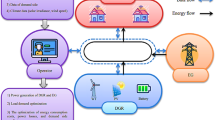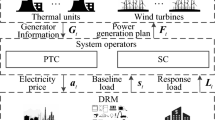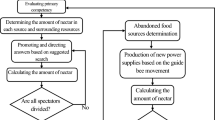Abstract
Locational marginal prices (LMPs) are economic signals paramount to the deliberations, policy designs, and planning judgments of most electricity markets. This paper presents a general metaheuristic-based methodology applied in the scope of two subproblems to compute and decompose the LMPs considering the incorporation of a distributed slack bus model in the power flow formulation. The deterministic core of the methodology is governed by a process of sequential setting of maximum number of metaheuristic iterations based on load disharmony indices (LDIs) in the context of the initial subproblem. The metaheuristic crux of the methodology is anchored in a random initialization strategy based on time-traveling parameters in the environment of both subproblems. In the introductory arrangement of the optimization sequence, the chain order of the operating horizon periods is defined based on the LDIs. Due to its notorious merits and the breadth of its applications in power system problems, a particle swarm optimization (PSO) algorithm model is used to solve the mentioned subproblems. For the practical purposes of this paper, in the PSO algorithm model instance the particle coordinates are adopted as time-traveling metaheuristic parameters. Numerical simulations on a 3-bus system and on the IEEE 30-bus test system corroborate the efficiency and adequacy of the proposed methodology.












Similar content being viewed by others
Availability of data and material
All data pertinent to theoretical foundations, mathematical corroborations, and computational simulations concerning the present work are extracted from sources duly cited in the scope of this manuscript. In addition, the data defined by the authors are also adequately described throughout the body of the aforementioned manuscript.
Abbreviations
- \(\varvec{\theta}^{t}\) :
-
Vector of voltage angles at all buses at period \(t\) excluding the angular reference bus
- \(p_{ds}^{t}\) :
-
Active power injection at the distributed slack bus at period \(t\)
- \(\varvec{p}^{t}\) :
-
Vector of net active power injections at all buses at period t
- \(\varvec{f}^{t}\) :
-
Active power flow functions at all buses at period \(t\)
- \(\varvec{fl}^{t}\) :
-
Vector of active power flow at all branches at period \(t\)
- \(\lambda_{ds}^{t}\) :
-
LMP at the distributed slack bus at period \(t\)
- \(\varvec{\lambda}^{t}\) :
-
Vector of LMPs at all buses at period \(t\)
- \(\varvec{\lambda}_{e}^{t} ,\varvec{\lambda}_{l}^{t} ,\varvec{\lambda}_{c}^{t}\) :
-
Vectors of energy, loss, and congestion components of LMPs at period \(t\)
- \(\varvec{\mu}^{t}\) :
-
Vector of Lagrange multipliers associated with the inequality constraints of active power flows at all branches at period \(t\)
- \(\varvec{\pi}^{\hbox{max} t} ,\varvec{\pi}^{\hbox{min} t}\) :
-
Vectors of Lagrange multipliers associated with the inequality constraints of upper and lower limits of generator outputs at period \(t\)
- \(\varvec{\eta}^{t}\) :
-
Vector of participation factors at period \(t\)
- \(0_{i} ,1_{i}\) :
-
\(i \times 1\) vectors fully integrated by zeros and ones
- \(\sigma_{i}^{t}\) :
-
Load disharmony index at time slot \(t\) with respect to total load at period \(i\)
- \(\varvec{X}_{j,t}^{ite} ,\varvec{V}_{j,t}^{ite}\) :
-
Vector of position and velocity coordinates of a particle \(j\) at iteration \(ite\) of the PSO algorithm at period \(t\) of the time horizon
References
Schweppe FC, Caramanis MC, Tabors RD, Bohn RE (1988) Spot pricing of electricity. Kluwer, Norwell
Hogan WW (1992) Contract networks for electric power transmission. J Reg Econ 4(3):211–242
Cheng X, Overbye TJ (2006) An energy reference bus independent LMP decomposition algorithm. IEEE Trans Power Syst 21(3):1041–1049
River M, Pérez-Arriaga IJ (1993) Computation and decomposition of spot prices for transmission pricing. In: Proceedings of 11th power systems computation conference (PSCC), pp 371–378
Litvinov E, Zheng T, Rosenwald G, Shamsollahi P (2004) Marginal loss modeling in LMP calculation. IEEE Trans Power Syst 19(2):880–888
Wu T, Alaywan Z, Papalexopoulos AD (2005) Locational marginal price calculations using the distributed-slack power-flow formulation. IEEE Trans Power Syst 20(2):1188–1190
Sarkar V, Khaparde SA (2011) Optimal LMP decomposition for the ACOPF calculation. IEEE Trans Power Syst 26(3):1714–1723
Kennedy J, Eberhart R (1995) Particle swarm optimization. In: Proceedings of IEEE international conference on neural networks (ICNN), pp 1942–1948
Alamaniotis M, Bargiotas D, Bourbakis NG, Tsoukalas LH (2015) Genetic optimal regression of relevance vector machines for electricity pricing signal forecasting in smart grids. IEEE Trans Smart Grid 6(6):2997–3005
Liang H, Liu Y, Shen Y, Li F, Man Y (2018) A hybrid bat algorithm for economic dispatch with random wind power. IEEE Trans Power Syst 33(5):5052–5061
Mohan V, Singh JG, Ongsakul W (2017) Sortino ratio based portfolio optimization considering EVs and renewable energy in microgrid power market. IEEE Trans Sustain Energy 8(1):219–229
Bhattacharya A, Chattopadhyay PK (2010) Biogeography-based optimization for different economic load dispatch problems. IEEE Trans Power Syst 25(2):1064–1077
Chandrasekaran K, Simon SP (2013) Optimal deviation based firefly algorithm tuned fuzzy design for multi-objective UCP. IEEE Trans Power Syst 28(1):460–471
Siano P, Mokryani G (2013) Assessing wind turbines placement in a distribution market environment by using particle swarm optimization. IEEE Trans Power Syst 28(4):3852–3864
Reddy SS, Momoh JA (2015) Realistic and transparent optimum scheduling strategy for hybrid power system. IEEE Trans Smart Grid 6(6):3114–3125
De M, Goswami SK (2014) Optimal reactive power procurement with voltage stability consideration in deregulated power system. IEEE Trans Power Syst 29(5):2078–2086
Cai HR, Chung CY, Wong KP (2008) Application of differential evolution algorithm for transient stability constrained optimal power flow. IEEE Trans Power Syst 23(2):719–728
Yumbla PEO, Ramirez JM, Coello CAC (2008) Optimal power flow subject to security constraints solved with a particle swarm optimizer. IEEE Trans Power Syst 23(1):33–40
Ebrahimi J, Hosseinian SH, Gharehpetian GB (2011) Unit commitment problem solution using shuffled frog leaping algorithm. IEEE Trans Power Syst 26(2):573–581
Sedghi M, Ahmadian A, Aliakbar-Golkar M (2016) Optimal storage planning in active distribution network considering uncertainty of wind power distributed generation. IEEE Trans Power Syst 31(1):304–316
Wan C, Niu M, Song Y, Xu Z (2017) Pareto optimal prediction intervals of electricity price. IEEE Trans Power Syst 32(1):817–819
Dashtdar M, Najafi M, Esmaeilbeig M (2020) Calculating the locational marginal price and solving optimal power flow problem based on congestion management using GA-GSF algorithm. Electr Eng 102:1549–1566
Castillo A, Lipka P, Watson J, Oren SS, O’Neill RP (2016) A successive linear programming approach to solving the IV-ACOPF. IEEE Trans Power Syst 31(4):2752–2763
Kiran D, Abhyankar AR, Panigrahi BK (2018) Decomposition of market-settlement surplus using pseudo-IV-optimal power flow. IEEE Trans Power Syst 33(4):3812–3821
O’Neill RP, Dautel T, Krall E (2011) Recent ISO software enhancements and future software and modeling plans. Staff Report, Federal Energy Regulatory Commission (FERC), Washington, DC (USA)
Deng Z, Rotaru MD, Sykulski JK (2020) Kriging assisted surrogate evolutionary computation to solve optimal power flow problems. IEEE Trans Power Syst 35(2):831–839
AlRashidi MR, El-Hawary ME (2007) Hybrid particle swarm optimization approach for solving the discrete OPF problem considering the valve loading effects. IEEE Trans Power Syst 22(4):2030–2038
Todorovski M, Rajičić D (2006) An initialization procedure in solving optimal power flow by genetic algorithm. IEEE Trans Power Syst 21(2):480–487
Bakirtzis AG, Biskas PN, Zoumas CE, Petridis V (2002) Optimal power flow by enhanced genetic algorithm. IEEE Trans Power Syst 17(2):229–236
Kang Q, Zhou M, An J, Wu Q (2013) Swarm intelligence approaches to optimal power flow problem with distributed generator failures in power networks. IEEE Trans Autom Sci Eng 10(2):343–353
Shilaja C, Arunprasath T (2019) Optimal power flow using moth swarm algorithm with gravitational search algorithm considering wind power. Future Gener Comput Syst 98:708–715
Li S, Gong W, Wang L, Yan X, Hu C (2020) Optimal power flow by means of improved adaptive differential evolution. Energy 198:1–13
Nguyen TT (2019) A high performance social spider optimization algorithm for optimal power flow solution with single objective optimization. Energy 171:218–240
Warid W (2020) Optimal power flow using the AMTPG-Jaya algorithm. Appl Soft Comput 91:1–10
Kennedy J, Mendes R (2002) Population structure and particle swarm performance. In: Proceedings of IEEE congress on evolutionary computation (CEC), pp 1671–1676
Eslami M, Shareef H, Taha MR, Khajehzadeh M (2014) Adaptive particle swarm optimization for simultaneous design of UPFC damping controllers. Int J Electr Power Energy Syst 57:116–128
Park J, Jeong Y, Shin J, Lee KY (2010) An improved particle swarm optimization for nonconvex economic dispatch problems. IEEE Trans Power Syst 25(1):156–166
Naderi E, Pourakbari-Kasmaei M, Abdi H (2019) An efficient particle swarm optimization algorithm to solve optimal power flow problem integrated with FACTS devices. Appl Soft Comput 80:243–262
Azizivahed A, Narimani H, Naderi E, Fathi M, Narimani MR (2017) A hybrid evolutionary algorithm for secure multi-objective distribution feeder reconfiguration. Energy 138:355–373
Azizivahed A, Naderi E, Narimani H, Fathi M, Narimani MR (2018) A new bi-objective approach to energy management in distribution networks with energy storage systems. IEEE Trans Sustain Energy 9(1):56–64
Naderi E, Azizivahed A, Narimani H, Fathi M, Narimani MR (2017) A comprehensive study of practical economic dispatch problems by a new hybrid evolutionary algorithm. Appl Soft Comput 61:1186–1206
Bouffard F, Galiana FD, Conejo AJ (2005) Market-clearing with stochastic security—part II: case studies. IEEE Trans Power Syst 20(4):1827–1835
Fox B, Flynn D, Bryans L, Jenkins N, Milborrow D, O’Malley M, Watson R, Anaya-Lara O (2007) Wind power integration: connection and system operational aspects, 1st edn. IET, London
Brazilian Independent System Operator (ONS) (2018) Hourly load curve. http://www.ons.org.br/Paginas/resultados-da-operacao/historico-da-operacao/curva_carga_horaria.aspx. Accessed 14 June 2019 (in Portuguese)
Christie RD (1999) Power systems test case archive. http://www2.ee.washington.edu/research/pstca/. Accessed 06 May 2019
Alsac O, Stott B (1974) Optimal load flow with steady-state security. IEEE Trans Power App Syst PAS 93(3):745–751
Meisel J (1993) System incremental cost calculations using the participation factor load-flow formulation. IEEE Trans Power Syst 8(1):357–363
Funding
This study was financed in part by the Coordenação de Aperfeiçoamento de Pessoal de Nível Superior—Brasil (CAPES)—Finance Code 001.
Author information
Authors and Affiliations
Contributions
All authors made indispensable contributions to the conception and elaboration of the present work. The literature review, code implementations, and data acquisition were performed by Felipe Oliveira Silva Saraiva. The analysis and interpretation of the simulation results were performed by Felipe Oliveira Silva Saraiva and Vicente Leonardo Paucar. Finally, the definitive critical survey of the work was carried out by Vicente Leonardo Paucar. It is worth mentioning that all authors endorse the final version of this manuscript by mutual agreement.
Corresponding author
Ethics declarations
Conflicts of interest
The authors declare that they have no conflict of interest.
Additional information
Publisher's Note
Springer Nature remains neutral with regard to jurisdictional claims in published maps and institutional affiliations.
Rights and permissions
About this article
Cite this article
Saraiva, F.O.S., Paucar, V.L. General metaheuristic-based methodology for computation and decomposition of LMPs. Electr Eng 103, 793–811 (2021). https://doi.org/10.1007/s00202-020-01112-5
Received:
Accepted:
Published:
Issue Date:
DOI: https://doi.org/10.1007/s00202-020-01112-5




